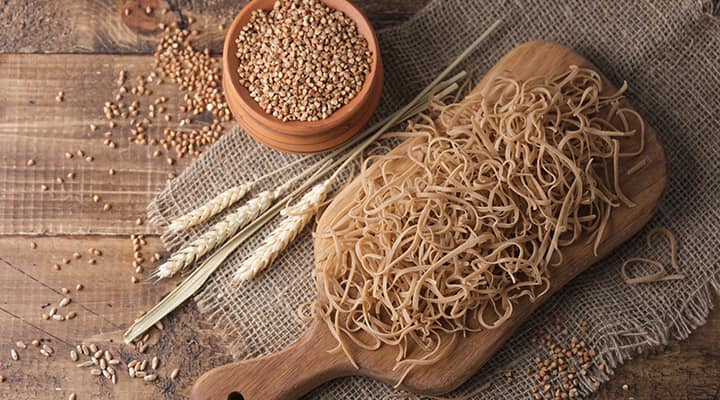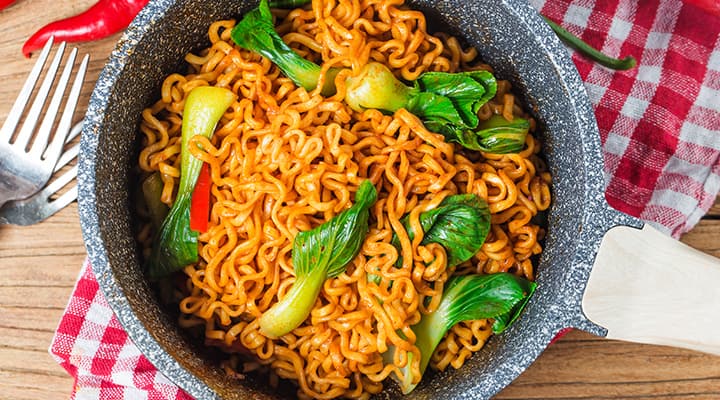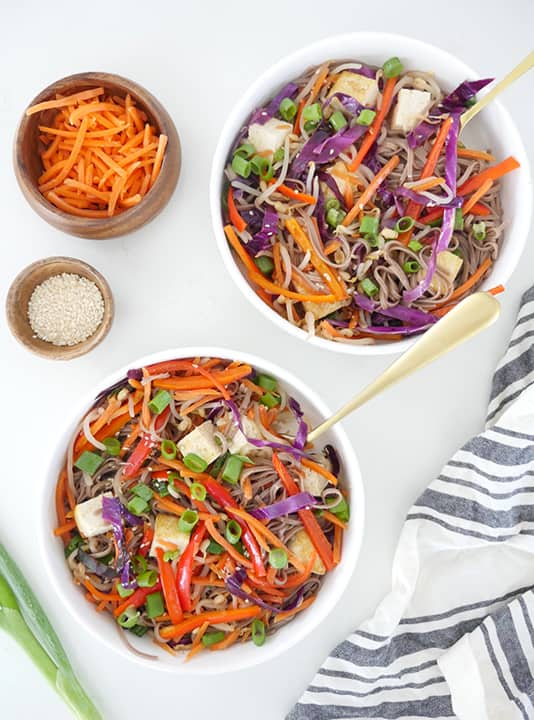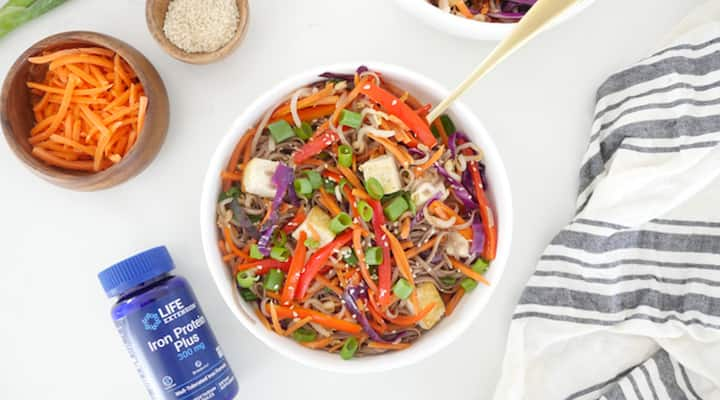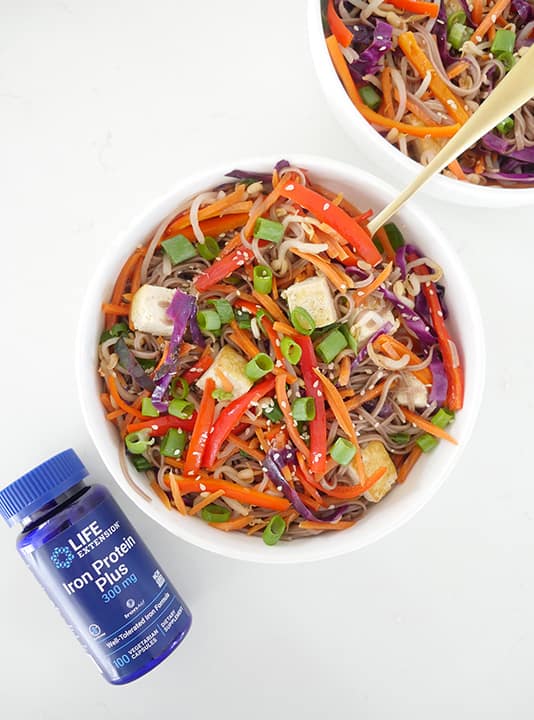
Is Buckwheat Gluten Free? (+ Buckwheat Noodles Recipe)
Published: June 2022
Looking to add a whole grain to your gluten-free diet? Look no further than buckwheat! This versatile plant-based superfood can be cooked into buckwheat porridge, roasted and tossed into salads or soups, or ground into flour to use in pancakes and homemade soba noodle recipes. And thanks to its gluten-free status, buckwheat is an excellent alternative for those with gluten sensitivities or gluten allergies.
Here is everything you need to know about buckwheat—plus, keep scrolling for a delicious buckwheat recipe featuring sesame noodles!
What is buckwheat?
Buckwheat, also known as “grechka” or “kasha,” comes from the Fagopyrum esculentum plant. It has been cultivated for thousands of years and is classified as an ancient grain. Like quinoa—another ancient grain—buckwheat is a pseudocereal, meaning its seeds are consumed as cereal grains even though it is not a wheat.
Is buckwheat flour gluten free?
Buckwheat is naturally gluten free. Despite the “wheat” in its name, buckwheat is actually related to rhubarb, a leafy spring vegetable. It is not related to wheat, a common grain avoided on a gluten-free diet. Other naturally gluten-free grains include amaranth, sorghum, quinoa, oats, teff and brown rice.
Does buckwheat flour contain wheat?
Buckwheat does not contain wheat, but it is important to read the ingredient list of any buckwheat product. In processing, buckwheat products could easily be cross-contaminated with gluten-containing whole grains, such as wheat, barley and rye. Cross contamination can occur during cooking, but it can also happen if it is processed in the same facility or on shared equipment with gluten-containing grains.
Can buckwheat flour be eaten raw?
Buckwheat flour is made by grinding up the seeds of the buckwheat plant. While buckwheat groats (the hulled seeds) can be eaten raw, the groats are best incorporated into buckwheat recipes for optimal taste and digestibility.
Does buckwheat taste good?
Buckwheat has a nutty, earthy, slightly bitter flavor, similar to whole wheat or rye. Because of its stronger flavor compared with other common grains—such as rice and oats—in recipes, buckwheat flour is usually used in combination with another, more mild-tasting flour. Many people also enjoy buckwheat groats, which can be eaten as a breakfast.
What to do with buckwheat flour: Recipe ideas
Buckwheat flour comes in two store-bought forms – light, made with hulled buckwheat, and dark, made with un-hulled buckwheat. Alternatively, you can make your own buckwheat flour at home—and you don't even need a recipe or fancy equipment to do so...just blend raw buckwheat groats in a blender or food processor.
Buckwheat flour can be used to make homemade soba noodles, varnishkes (bowtie pasta), scones, blini, and other baked good recipes.
Buckwheat pasta and buckwheat noodles, or soba noodles, have become increasingly popular in the U.S. These Japanese noodles can be purchased pre-made at the grocery store or made from scratch, and they can be enjoyed in both hot and cold dishes. Some store-bought soba noodles are made with buckwheat flour alone. Others, like Hakubaku soba noodles, are made with wheat and buckwheat flour.
Yakisoba is a popular stir-fry recipe made with soba noodles, bite-sized pork and finely chopped vegetables like cabbage, carrots and bean sprouts. Udon, another popular Japanese noodle, is similar in appearance but made with wheat flour rather than buckwheat. Both soba noodles and udon can be mixed into a salad—they both happen to taste especially good when cold!
Looking for a breakfast buckwheat recipe? Try groats! (We know, groats rhymes with "oats," but it's definitely a heartier, more textured consistency.) Another name for buckwheat groats is "kasha," which tastes really yummy with the aforementioned varnishkes.
And of course, you can always make perhaps the most popular buckwheat recipe—pancakes—by combining one cup buckwheat (ground) with an egg and water or milk.
Explore Our Best General Health & Wellness Supplements
How to make buckwheat noodles
Soba noodles are cooked like regular noodles. Simply immerse in boiling water, reduce to a simmer, and cook for about 5 minutes.
Soba noodles can be made from scratch using ½ cup all-purpose flour, 2 cups of organic buckwheat flour and ¾ cup of cold water. Combine the flour with water and knead until a crumbly dough is formed. Knead the dough until smooth, then roll out the dough and slice into noodles using a pastry cutter. Cook the soba immediately.
Gluten-Free Recipe: Sesame Buckwheat Noodles
This sesame soba noodle salad recipe is made with a flavorful dairy-free sesame sauce and can be enjoyed on its own or as a side dish. Made with a base of gluten-free buckwheat noodles, plant protein-rich tofu and crunchy vegetables, this plant-based, non-dairy noodle dish is one you’ll want to make over and over again.
Serves: 4
Preparation time: 10 minutes
Cooking time: 15 minutes
Total time: 25 minutes
Ingredients:
2 cups shredded carrots
2 cups shredded red cabbage
1 medium red bell pepper, cut into thin strips
16 oz. extra firm tofu, cubed
8 oz. dry buckwheat noodles or soba noodles
⅓ cup diced green onions
1 cup bean sprouts
1 tbsp olive oil
1 tbsp sesame seeds, toasted
Sesame sauce:
2 tbsp sesame oil
1 tbsp natural rice vinegar
¼ cup low sodium soy sauce
1/8 tsp ground black pepper
1 tsp minced garlic
Preparation:
- Bring a large pot of water to boil. Add soba noodles to the boiling water and cook for 4-5 minutes or until just tender, stirring occasionally. Drain in a colander and rinse well.
- While the noodles are cooking, whisk together sauce ingredients in a medium bowl.
- Heat a large skillet over medium-high heat. Pour olive oil into the skillet. Add tofu in a single layer and cook for 2-3 minutes on each side, flipping occasionally until slightly crisp on all sides. Remove from skillet and set aside.
- Place carrots, bell pepper, bean sprouts, red onion and green onion in the skillet and cook until tender, about 60 seconds. Add tofu, noodles and sauce to the skillet with sautéed vegetables and stir to combine. Top with toasted sesame seeds before serving. Serve in dish or bowl.
How to cook buckwheat noodles without sticking
When the noodles finish cooking, transfer them to a bowl of cold water and stir to prevent clumping and sticking. Rinsing them with cold water in a colander also works.
How long do buckwheat noodles last?
Soba noodles last about three days to a week after they are cooked. When they are dry, they can last up to two years on the shelf.
What goes with buckwheat noodles?
Soba noodles are the perfect blank canvas for sauteed vegetables, lean protein like chicken or tofu, and a flavorful sauce. Soba is often used in place of rice or other grains. Experiment with a variety of recipes until you find the dish (or dishes) that suit your tastes!
Are buckwheat noodles keto-friendly?
No, soba is not good for those on a keto diet. They contain about 42 grams of carbohydrates per 2 ounce serving.
Why are buckwheat noodles good for you?
Buckwheat noodles contain many nutrients. Even though buckwheat noodles are made up primarily of carbohydrates, they contain fiber, including resistant starch. This prebiotic is fermented by gut bacteria in the colon to produce short-chain fatty acids (SCFAs) that feed the lining of the colon to support gut health.
Soba noodles are virtually fat-free, and offer considerable protein compared with other whole grains; buckwheat is one of the few sources of complete high-quality plant-based protein.
Manganese is an abundant mineral found in buckwheat noodles, which is essential for the normal functioning of your brain and nervous system. Additionally, soba noodles are a good source of B vitamins, which help convert the food we eat into useable energy. Buckwheat also has been recognized as having antioxidant activity.
Can you get enough iron from buckwheat noodles?
While buckwheat is a good source of iron, it is in the form of plant-based non-heme iron, which is less bioavailable to the body than the heme iron found in animal foods. This means buckwheat isn’t a sufficient source of iron for people following a vegan diet; indeed, the RDA of iron for vegetarians is 1.8 times higher than for people who eat meat. (While there are many health benefits to being vegan, iron is only one of several nutrients of concern that people following plant-based diets need to look out for.)
For those who follow a mostly plant-based diet, an iron supplement may be of benefit to help ensure you are meeting our needs. Life Extension’s Iron Protein Plus contains iron protein succinylate, a highly absorbable form of iron that is easier on the stomach than other forms of iron. (Women who are not vegans also may need an iron supplement; women’s iron needs are significantly higher than men’s.) Iron is important for promoting healthy red blood cell formation, supporting immune health and more.
Wondering what essential vitamins and minerals you might benefit from? You can get a personalized recommendation using Life Extension’s Health Needs Quizzes.
References:
- Noreen S, et al. “Health Benefits of Buckwheat (Fagopyrum Esculentum), Potential Remedy for Diseases, Rare to Cancer: A Mini Review.” Infect Disord Drug Targets. 2021, https://pubmed.ncbi.nlm.nih.gov/33357186/
- Sytar, O, et al. “The Contribution of Buckwheat Genetic Resources to Health and Dietary Diversity.” Current genomics. June 2016, https://www.ncbi.nlm.nih.gov/pmc/articles/PMC4869006/
- Topping DL, Clifton PM. “Short-chain fatty acids and human colonic function: roles of resistant starch and nonstarch polysaccharides.” Physiol Rev. July 2001, https://pubmed.ncbi.nlm.nih.gov/11427691/
- “Iron – Fact Sheet for Health Professionals.” NIH, https://ods.od.nih.gov/factsheets/Iron-HealthProfessional/
Like what you read?
Please subscribe to get email updates on this blog.


